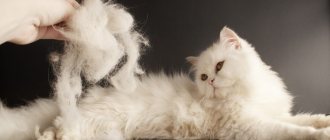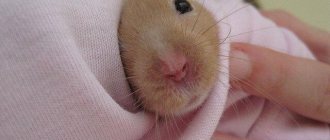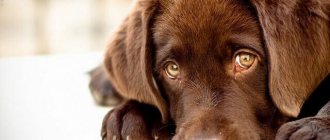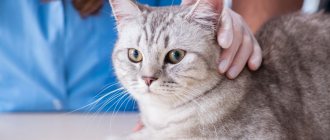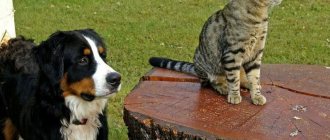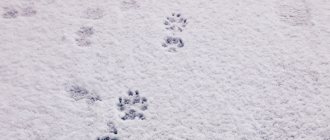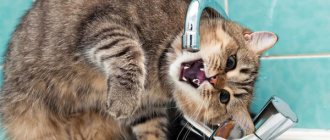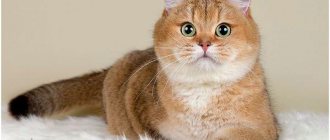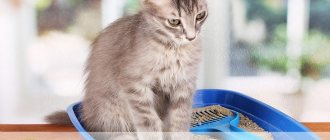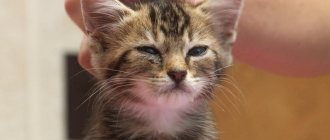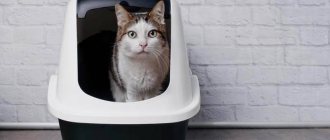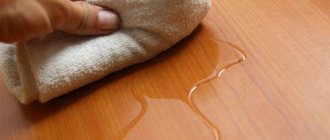Frequently asked questions about chinchilla breeding
When purchasing chinchillas for breeding and sale, various questions arise.
Why chinchillas don’t reproduce - the main reasons for refusing to mate
Reasons for refusal to mate may be:
- inappropriate age of the couple;
- weak or sick animal;
- improper conditions of care and maintenance;
- individual qualities.
At what age are chinchilla babies ready to “say goodbye to mommy”?
Chinchilla cubs weigh on average 30-75 grams, require mother's milk and continue to eat it for another two months. Small chinchillas are allowed to be separated from an adult female when the weight of the babies reaches 200-260 grams.
Can relatives of chinchillas mate?
To exclude sick and weak offspring with birth defects, it is not recommended to mate chinchilla relatives.
How to make friends with a future chinchilla pair before mating?
Before placing one animal with another, it is recommended:
- choose a cage with a height of less than one meter and a width of 75 cm;
- thoroughly wash the enclosure before adding the chinchillas;
- remove all foreign objects from the cage so that the animals are not injured during a possible fight;
- build a maze of boxes so that the male can escape if the female shows aggression;
- roll the female in sand with the male's feces, and place the male rodent in the female's uncleaned cage;
- first place the male in his cage, and place the female next to him;
- the owner of the animals must observe the behavior of the couple for four hours. If chinchillas begin to show aggression or fight, they are immediately isolated and given medical care;
- to distract rodents from the conflict, it is necessary to add coarse hay to the enclosure - it will distract them from rude behavior;
- You will have to observe the behavior of the animals until the end of the day;
- It is recommended to feed the couple with high-quality food that includes fresh fruits, useful microelements, and various vitamin supplements;
- wait patiently until your beloved pets prepare to reproduce;
- if mating has not occurred for a long time, start looking for another partner.
Shedding fur
Shedding fur should not be confused with the natural process of shedding.
A chinchilla should shed slowly and regularly. Therefore, if a chinchilla is completely bald, perhaps something has frightened it very much.
Rapid fur release is a defense mechanism used when a chinchilla feels trapped or threatened. Animals often use this in the wild, for example if a chinchilla is caught by a predator. But they can also release the fur lining if they are in a stressful situation.
Shedding fur is also a natural process and should not cause much concern to pet owners. If your hairless chinchilla is feeling normal, carefully inspect all exposed areas of his skin. You don't need to go to the vet or treat the bare skin area unless it starts to look painful.
Parasites in chinchillas
Like all animals, they are sometimes tormented by various parasites and worms. It is very easy to become infected with them, but the consequences are quite serious if treatment is not started in time.
How chinchillas can become infected with parasites:
- From contaminated feed, water or hay
- Due to unsanitary conditions in the premises and infrequent cleaning
- Contact with infected individuals
- From the man himself
Symptoms of infection in chinchillas:
- Symptoms of dysfunction of the digestive organs
- The fur changed color and became dull
- Feces smell strong and usually become soft
- Weight gradually decreases
- The animal behaves very lethargically
Self-treatment is difficult because you know exactly what parasites your chinchilla has picked up. Therefore, it is better to first take the chinchilla itself or its boluses for testing. The veterinarian will prescribe the appropriate treatment and you can already do it at home.
There is also a separate article on our website about the treatment of parasites in chinchillas.
Allergy
If the body is hypersensitive to various irritants, the following symptoms can be observed in an animal:
- conjunctivitis;
- inflammation of the eyelids;
- lacrimation;
- sneezing;
- dyspnea.
An allergic reaction accompanies the following situations:
- switching from one type of feed to another, this applies to both ready-made mixtures and those prepared by the owner (dusty hay);
- bedding materials;
- hygienic sand for bathing chinchillas;
- an allergic reaction to toxic substances released by internal parasites.
Conjunctivitis in chinchillas
Stress in a chinchilla
It is stress that most often causes coat problems in chinchillas. A sudden change of environment, an unusual situation, new people, loud noises - all this can cause stress in a timid animal. Sometimes shedding from stress can be so severe that the fur literally comes out in clumps. This condition can be treated simply - leave the animal alone as much as possible and all problems will go away. Very often, hair loss occurs as a result of some negative event or stress. Like all other rodents, chinchillas are highly sensitive to the following factors:
- change;
- moving;
- the emergence of new people;
- new items in the cage;
- the appearance or death of another domestic animal;
- lack of communication with the owner.
When a stressful situation occurs, the fur begins to come out in large quantities in clumps, which is the reason for the appearance of bare areas on the animal’s body. The problem can be solved quite simply:
providing the chinchilla with a calm environment; attention from the owner; gentle and calm treatment; introducing the animal’s favorite treats into the diet.
Lichen
Microscopic fungi brought from outside by animals or people are the cause of lichen. Round or oval bald patches of skin appear that quickly increase in size. They are located on the nose, around the eyes, on the paws and near the tail.
If action is not taken quickly, the rodent's entire body will become a complete bald spot, covered with a flaky crust. This is dangerous not only for sick animals, but also for all inhabitants of the house. If the animal begins to itch and bite its fur, there is a reason for a careful examination. If lichen is detected, be sure to visit a veterinarian with all animals, including cats and dogs.
ATTENTION! If an infection is detected, the first thing to do is isolate the rodent and disinfect the cage. Add mycodermatitis to the bathing sand.
If a visit to the veterinarian is not possible, the lesions should be treated with one of the drugs: lamisil, exoderil, chlorhexidine, medical sulfur. If extensive damage is observed, 1/14 tablets of Nizoral are administered daily for a month. If you have the Vakderm F vaccine, give injections of 0.3-0.5 ml for 10 days. After missing 10 days, the course is repeated. You need to do 30 injections. Possible increased hair loss.
IT IS IMPORTANT! Before purchasing chinchillas, be sure to study the list of necessary medications and first aid kit equipment.
Diseases
Any disease affects the appearance of the animal - the fur gets wet, the hairs become brittle and fall out profusely. If such symptoms appear simultaneously with discharge from the eyes, ears, mouth, nose, etc., this is a reason for a careful examination and identification of the disease. Most often the gastrointestinal tract suffers from:
- Diarrhea. The reason is overexcitement, bad water or moldy food. Treat with herbal infusions (calamus, wild rosemary) and phthasol with charcoal. If treatment is unsuccessful, biomycin or tetracycline is given (the dosage is determined by the veterinarian).
- Constipation. The reason is infection, lack of water, stress. If the abdomen is hard and there are no signs of bowel movements, a laxative, plenty of fluids and juicy fruits should be given.
- Gastroenteritis. The intestines and stomach are inflamed due to poor nutrition or a sudden change in nutrition. Treat with rosehip decoction and a balanced meal.
The animal will have bad fur and will stop moving due to diseases of the genital organs, mammary glands, malocclusion, bad teeth, jaundice, and cystitis. Only a professional can handle such serious diseases.
Why does a chinchilla go bald?
Let's start with the main thing. Unlike dogs and cats, chinchillas do not shed. At least in the usual sense of the word.
At the age of one, the chinchilla's baby coat is replaced by an adult one, and the animal's hair is renewed every day, just like a human's. But chinchillas do not shed, when the old fur falls out in clumps and a new one grows in its place.
If you notice that your pet has begun to go bald, you need to urgently contact a specialist. Hair loss clearly indicates that something is wrong with the chinchilla, and the sooner you fix the problem, the better. In the meantime, let's go over the main causes of hair loss so that you are on the alert and can prevent this trouble.
5 Causes of Hair Loss in Chinchillas
Stress
Stress is the main cause of baldness in chinchillas. Almost always, when it comes to hair loss, it is he who is to blame.
When a chinchilla experiences extreme anxiety, its body interprets this as a threat to its life. To survive, he “turns off” “unnecessary” organs and protects the primary ones - those without which it is impossible to survive. The body nourishes the skin and fur last, so the hair begins to fall out.
What to do?
Identify the cause of stress and eliminate it. Get examined by a veterinarian. Usually, after eliminating the cause of stress, hair stops falling out within a few days.
Lack of vitamins and minerals
Monotonous, poor-quality or inappropriate nutrition leads to an imbalance of substances in the body. The skin and wool do not receive sufficient nutrition and cannot cope with their function. The fur becomes dull, brittle and falls out.
What to do?
Adjust your diet. If necessary, administer vitamins (only in consultation with your doctor).
Incorrect conditions of detention
Wool may fall out due to unsuitable temperature conditions. The optimal temperature for chinchillas is 16-20 degrees. If a rodent gets hot, it begins to shed its fur.
Hair loss can also be caused by a cramped cage, lack of exercise, boring leisure time and lack of attention.
Skin diseases, allergies
With these diseases, as a rule, hair loss is combined with changes in the skin in the form of irritations or spots. The most common problems are dermatitis, lichen, food allergies.
What to do?
Contact a veterinarian for diagnosis and treatment.
Parasite infestation
Internal (helminths) and external (such as fleas) parasites are another cause of hair loss. Worm infestation weakens the immune system, which can cause the animal to begin to lose its fur. And the bites of external parasites cause such discomfort to the pet that he himself begins to bite and pull out the fur.
What to do?
Carry out antiparasitic treatment as prescribed by a veterinarian.
Diseases of internal organs
Sometimes the cause of baldness is hidden deep inside. Hair loss in a chinchilla can be one of the symptoms of chronic or newly developing diseases, which the owner may not be aware of.
What to do?
Take your chinchilla to a veterinarian for examination.
Take care of your pets, and let their coat always be shiny!
Dermatitis
Skin diseases cause unbearable suffering to cute animals. To get rid of the itching, they rush around restlessly, scratch with blood and quickly lose a lot of hair.
The cause of dermatitis is impaired metabolism, intolerance to dietary components, and pathogenic fungus. If a disease is detected, you cannot treat it yourself. It will be prescribed by a veterinarian after a complete examination.
Often hair falls out due to allergies
How does the molting process work?
Chinchillas can shed at intervals of several weeks. The process of shedding their fur starts from their head and moves towards the tail. New fur begins to grow and pushes out the old one.
During this process, you can notice a clear line on the fur. This line, known as the primer line, is the area where the fur coat is currently being renewed. The line will gradually move down the entire body until the coat is completely renewed. The animal wears a new coat for several weeks before it is time to begin the molting process again.
The process occurs all year round, however it can be noted that animals shed more fur in the summer or spring to keep cool than in the winter months.
Fungus
Fungal infections cause diseases such as trichophytosis and microscopy, otherwise these ailments are called lichen. The diseases have similar symptoms: it all starts with the appearance of regularly defined oval or round scaly or blistered areas on the chinchilla’s skin. Then hair loss begins, and if you miss the moment and do not carry out treatment, then in a very short time the animal will become completely bald.
If the veterinarian confirms the presence of lichen, the owner should remember that the disease is very contagious and can be transmitted to humans. Animals are treated with injections, tablets, sprays, ointments - it all depends on the degree of damage.
Why does a chinchilla shed?
Like most other animals, chinchillas shed to freshen up their coat. This is similar to how a person sheds dead skin cells. Shedding chinchillas is a way for them to refresh and maintain a healthy coat. Washing your pet is strictly not recommended, because this is almost the only way for him to cleanse himself without unnecessary stress. If your chinchilla is hairless because she constantly sheds her fur, it means that you are handling her too roughly. Don't grab it by the tail, don't try to catch it. Let your communication be more relaxed, then you will definitely make friends.
chinchilla shedding
Chinchillas also shed to control their temperature. It is difficult for them to regulate their body temperature, but it is vital. Heat can lead to serious health problems. So in the warm season they need to shed excess fur to prevent overheating. During the spring and summer, you may notice that your chinchilla is losing more hair than usual. This is a natural process that keeps them healthy.
Owners of exotic rodents often wonder whether chinchillas shed as a result of age-related changes. It is impossible to give an exact answer to this question, since everything is quite individual. Rather, on the contrary, the animal stops molting due to disturbances in heat exchange, which at a young age works “like a clock.”
It is also important to find out whether chinchillas kept at home shed from this or that type of food. In fact, hair loss is usually caused by a lack of vitamins.
The animal should receive only balanced nutrition; skimping on quality can cost her health or even her life.
Microclimate disturbance
The natural conditions for exotic animals are a mountain climate, where the temperature is constant at 16-18 degrees. That is why they have such beautiful, thick fur. Exceeding the temperature provokes hair loss to cool the body.
Extreme heat, stale air, and high humidity can lead to redness, peeling of the skin and even death. To avoid this, in winter you do not need to place the chinchilla’s cage near heating devices and radiators, or place it on windowsills in direct sunlight. In summer, to create a comfortable temperature you need air conditioning and the absence of drafts.
Disadvantages of keeping chinchillas at home
- Chinchillas are nocturnal animals, so you should be prepared for night noises in the cage; you should not place it in the bedroom. When getting this rodent, you should be prepared to hear rustling, eating food, jumping and funny games every night.
- Despite the fact that the cage for such an animal should not be too large, it should also not be too small, especially in terms of height, it should have shelves on which the chinchilla could crawl and jump.
- Rodents also take sand baths; they cannot be prohibited from doing this, because such a procedure is necessary for them and is strictly prohibited. Therefore, you will have to clean the area next to the cage; scattered sand will often be found everywhere. Also, at least once a day you will still have to take care of your pet, that is, provide new hay and food, as well as pour fresh water.
- If you decide to let the rodent out for a walk around the apartment, you will need to monitor it very carefully. The point is that chinchillas can eat your furniture, wires, and also get into a place from which you will have to rescue the animal. The owner can turn away literally for a second, and the animal will already find itself in an unpleasant situation.
- It is extremely undesirable for these animals to endure stressful situations, and such for them can be an ordinary loud sound or a sudden movement in front of the cage during the day. Also, not all animals like to be cuddled, so it is not a fact that you will be able to play with your pet every day, but if you pick it up forcibly, this can negatively affect the health of the animal. Also, chinchillas need to be provided with optimal temperature conditions, they do not like heat, the maximum temperature for their life is +26 degrees, but if the temperature in your apartment is higher, then you will have to cool it with an air conditioner.
So, being at home has its positive and negative aspects.
What medications are recommended?
Special vitamins can be bought at the pharmacy. They are divided into the following groups:
- Fat-soluble liquids. They are administered to animals one drop at a time from a dropper or disposable syringe.
- Soluble in water: “Vita Sol” (), “Vitamin Plus N”. () and others. They are added to drinking water. Since their structure quickly deteriorates when exposed to sunlight, it is best to add them to water in the evening.
- Powder: Vitamix and Vitapol. They are mixed with bran, dry food, dried and crushed grass;
- tablets “Ascorbic acid” and “Ascorutin”;
- Vitamins for children: Biovital Kinder gel and Multitab baby. Chinchillas love the sweet taste of these vitamins.
The course of fortification lasts 30 days, followed by a break and repetition if necessary.
Causes of unnatural shedding
Living in its natural habitat and taking into account the geographical location of its natural range, the chinchilla has not acquired genetic diseases and is very tolerant of changes in its diet.
A change in the main part of the coat occurs when the baby grows up and this is the only natural molting of a rodent. Unlike other animals, the chinchilla does not shed depending on the changing seasons and the process of molting in an adult is gradual. Caring for and maintaining an animal at home is not difficult.
Therefore, abnormal molting is a source of concern for the pet’s health. Common causes include skin diseases and nervous overload of the pet.
Stress
A common cause of hair loss is stress. A sudden change in the environment causes damage to the animal’s fragile nervous system, which affects the change in the structure of the coat. The transferred fear will lead to abundant tufts of hair coming out with the rapid appearance of bald patches.
The causes of stress include:
- Change of owner.
- Replacing the cage with a new house.
- Loud sounds, unexpected claps and calls. Severe fear from noise during repair work.
- Reaction to other pets.
- Sudden photo flash.
- Quick hand movements.
Friendly intonations in the owner's voice, affectionate treatment and favorite delicacies can calm the animal down.
A friendly environment will lead to the end of unnatural molting after some time.
Avitaminosis
When the season changes, hair coming out provokes a lack of vitamins in the rodent’s body. A monotonous diet and a lack of fresh vegetables and fruits in the diet lead to the onset of the disease.
Growing puppies, pregnant and aging animals are especially susceptible to the disease. A severe form of vitamin deficiency is accompanied by redness of bald areas of the skin, itching and subsequent peeling.
To fix the problem it is recommended:
- Enrich the composition of the finished feed by adding cereals containing vitamins A and D.
- Add dried hay and grass regularly.
- Purchase mineral supplements in the form of salt rock.
- Add fresh fruits and vegetables that contain a lot of moisture to your food.
- In case of severe skin damage, add the Multitabs vitamin complex to the drink at the rate of 1 drop per 100 grams of water. It is not advisable to administer vitamins intramuscularly due to the painfulness of the procedure and the aggravation of stress.
Important! During treatment, it is necessary to observe the behavior and condition of the animal. An excessive dose of vitamins causes hypervitaminosis, which extremely complicates the well-being of the rodent
Dermatitis
It cannot be said that dermatitis occupies a leading place among skin diseases in chinchillas.
Thanks to their excellent natural characteristics and strong immunity, rodents rarely suffer from dermatitis
However, insufficient attention of the owner to the condition of the pet's fur can lead to scratching, frequent biting and baldness of the skin.
To treat an animal, you must visit a veterinarian to prescribe medications.
Sand baths will help prevent the occurrence of dermatitis. In nature, to protect themselves from parasites, chinchillas bathe in volcanic sand. The finely ground substance absorbs excess moisture well, protects against colds and supports the overall well-being of your pet.
Incorrect content
The problem of hair loss is faced by owners who do not take into account the factors of chinchillas living in natural conditions. In the wild, the animals find stone cavities in the rocks located on the north side and use them as shelter. Therefore, animals accustomed to coolness find it difficult to stay in a room with elevated temperatures.
To avoid unnatural molting, the room with the cage must maintain an air temperature of no higher than +20 degrees.
In winter, install the enclosure in a far corner away from radiators, and in summer avoid direct sunlight. In hot weather, it is recommended to use air conditioning.
We recommend that you read:
Gnawing fur
A common occurrence in chinchillas is hair chewing. Upon external examination of the pet, the fur resembles an exotic haircut, with the sides, paws and tail most often affected.
Since the animal trims its own pieces of fur on its own, this does not apply to shedding.
Why does a chinchilla lose its fur in clumps, as if shedding? Sometimes such actions can be a reaction to a stressful situation after an injury or surgery. But often, a chinchilla with this behavior lets its owner know that it is bored.
In this case it will help:
Moving to a larger cage. Providing additional toys. Additional attention from the owner to the pet.
Allergic dermatitis
The desire to pamper your pet (more often occurring in children) with oranges, melons, exotic vegetables and fruits, and smoked products causes this disease. Less commonly, it occurs when changing food, eating untreated sand, and introducing toxic toys. Symptoms of allergic dermatitis:
- The animal often sneezes, itches and chews itself.
- Eyes turn red.
- Breathing disturbance appears, accompanied by wheezing or whistling.
- Bare islands of skin are formed.
You can eliminate the causes of allergic reactions by selecting food, explaining feeding rules to children, washing the cage and throwing away toys, especially those that have a strong unpleasant odor.
How to choose the right cage for a chinchilla
It is best to choose a wooden cage, you can buy it or make it yourself, in fact, it is not difficult. In a high-rise building, the cage should be large, because chinchillas love to jump.
The optimal dimensions are 1 meter in height and half a meter in width and length for each animal. The locks must be strong so that your pet cannot get out of the cage on his own, because there are many dangers in the apartment that can interrupt the life of a chinchilla.
The cage should be placed in a room where the constant temperature is about 22 degrees, and the cage should not be placed next to a radiator or in a draft. Also, your bedroom is not the best place for a cage; the fact is that chinchillas are most active at night, so they will disturb your sleep.
To properly keep a chinchilla in a cage, you need to install some accessories. For example, a house in which the chinchilla can be alone or hide from something, shelves on which she can jump and sit, a toilet, a feeder and a drinking bowl. There are also optional but still necessary accessories such as a running wheel, a hammock and ladders.
But you shouldn’t put a sand bath in a chinchilla’s cage; it should stand separately and these animals should be given a bath about once every three days. If you manage to equip the cage well, your pet will be happy and will live a long life with you.
Soft bag
Fabric carriers have been around for a long time, but their modern development has primarily affected the increase in the number of all kinds of windows, mesh and other little things. The cat will no longer sit in a dark bag, not much different from an ordinary travel bag. It is difficult to organize a comfortable long trip in such a device. But for short distances the convenience is quite adequate.
The advantage of a soft cage is its lightness, compactness, and the ability to securely attach it to a car seat or, for example, to the handle of a suitcase.
Negatives: Not hygienic for long trips and difficult to clean quickly (although they can withstand washing in a regular washing machine).
Cost – 1,360 – 1,489 rubles.
What to do if your British cat sheds a lot
In order to shorten the shedding period of a British cat, veterinary experts recommend using the following methods:
- Switch your pet to high-quality food and ensure your pet receives the necessary vitamins and microelements.
- In the autumn, reduce daylight hours for your pet - there is no need to leave your British cat in a lighted room in the evenings.
- Do not let the animal sleep on radiators or in other warm places. Be sure to ventilate the room at night.
- The air in the room where the cat is kept should not be dry.
In any case, such measures will help the molt proceed without complications and provide the animal with the greatest comfort.
Grooming
Regular brushing of fur during shedding is necessary not only to reduce soiling of carpets and sofas. This process is extremely important for the health of the British:
- during combing, the skin in the growth zone of the root bulbs is massaged;
- metabolism improves;
- the undercoat layer is ventilated.
If a cat is accustomed to brushing and does not panic at the sight of a brush, it enjoys it and its health improves.
Antiparasitic treatments
A mandatory procedure for British breed cats is annual vaccination and treatment against parasites (external and internal). These measures do not directly affect the molting process, but they improve health, prevent the development of a number of diseases and are always considered in conjunction with other preventive measures.
If a small British kitten sheds heavily, then first of all you need to ask whether its mother has been treated for worms, fleas and lice. Most often, at an early age, they become the cause of active shedding of fur.
Changing the indoor microclimate
The living conditions of a British cat affect how the pet sheds. In this sense, everything must be done to ensure that the animal experiences at least minimal changes in temperature and humidity, since the body is guided by the length of daylight hours and the accompanying climatic conditions.
The cat owner must:
- regularly ventilate the room;
- provide walks on the street or at least equip a place for the cat on the balcony;
- maintain an appropriate level of humidity in the house/apartment - dry air completely changes the structure of the hair and the molting cycle.
It is necessary to provide the animal with the opportunity to climb to high places and settle down there. Even within the same room, but at different levels, temperature and humidity change, and the cat itself finds the most comfortable place.
Reducing stress levels
The most common cause of stress for a British cat is noisy company in the house and lack of privacy. The breed prefers solitude rather than constant communication. Failure to comply with this condition leads to increased emotional stress, which can result in aggression or lead to the onset of prolonged molting. Once the source of the irritation is eliminated, your Briton will be at peace and will return to his normal coat changing routine.
Hair transplantation
In the second stage of the procedure, donor follicles are implanted into bald areas. For replanting, a special micro-instrument choi implanter is used with a needle thickness of 0.5-0.9 mm, selected so that the diameter of the instrument matches the size of the transplanted material.
Before implantation, the length of the follicle is measured using a microscope. Based on the data, the length of the implanter needle is adjusted, after which the follicles are implanted into the skin. Thanks to a special tool during transplantation, you can control the direction and angle of hair growth. These parameters are individual for patients and must be observed during transplantation. Where there is hair on the skin, grafts are placed parallel to their growth; if there is no hair, the natural direction is restored.
In addition, it is important to ensure that the hair has a natural thickness. Therefore, when transplanting, grafts with different numbers of hair follicles are used.
For example, one bulb is implanted along the edge of hair growth. Next, material with two or three follicles is implanted.
After transplantation, the transplantation area is treated with a special solution, which activates engraftment and hair growth.
Misfeeding
A lack of vitamins in an animal’s body, or vitamin deficiency, occurs very often due to the fact that the feeding diet is incorrectly formulated and consists of monotonous food. Most often, chinchillas encounter vitamin deficiency in the spring or autumn, because there is a reduction in succulent green food, due to the fact that it is very difficult to get it.
Improperly formulated diet Overcoming vitamin deficiency is quite simple:
- introduction of vitamins or injections into the diet, which include veterinary drugs containing essential microelements;
- Along with food, they give fresh fruits, vegetables, and herbs.
Vitamins are given for 14 days, dosage occurs individually for each animal.
We suggest you read: Feeding rabbits at home
Vitamins in excess lead to hypervitaminosis, one of the signs of this disease is also loss of fur, and in addition to this symptom, problems develop:
- with cardiovascular activity;
- breathing;
- digestion.
Lack of vitamins and minerals
The disheveled appearance of the rodent, faded, brittle fur sticking out in all directions, bare sides are signs of vitamin deficiency. Sometimes the skin may become red and itchy. This occurs in spring or early winter. The lack of juicy vegetables and fruits, berries, herbs in the diet, lack of salts and vitamins, and monotonous nutrition are its cause.
To prevent this phenomenon, you should feed the animal with ready-made, high-quality food from trusted manufacturers. The veterinarian will tell you in what proportions to introduce hay, apples, oats, alfalfa, nettle, rose hips, and hawthorn into the diet. He will also prescribe treatment for symptoms of vitamin deficiency. These are most often vitamins for wool in injections or drops.
